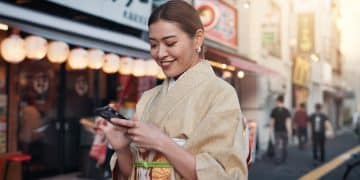Don’t Overpay: US Shopper’s Guide to Japanese Sales Tax

For US shoppers in Japan, understanding the country’s consumption tax, equivalent to sales tax, is crucial for budgeting and avoiding unexpected costs, as it impacts nearly all goods and services and differs from US state-based sales tax systems.
Venturing into the vibrant markets of Japan offers a thrilling experience for any US shopper, but navigating its unique tax system can be a puzzle. This comprehensive guide, Don’t Overpay: A US Shopper’s Guide to Understanding Japanese Sales Tax (Consumption Tax), aims to demystify the intricacies of Japan’s consumption tax, empowering you to shop smarter and avoid unexpected expenses during your trip.
Understanding Japan’s Consumption Tax Basics
When you’re shopping in Japan, you’ll encounter a tax called “consumption tax” (消費税, shōhizei). This is Japan’s equivalent of what Americans typically call sales tax. Unlike the varied sales tax rates across different states and even cities in the US, Japan generally has a unified, nationwide rate for consumption tax. Knowing this fundamental difference is the first step towards savvy shopping.
The consumption tax is levied on most goods and services domestically sold and consumed within Japan. This means that whether you’re buying a bento box at a convenience store, a souvenir at a department store, or paying for a train ticket, the tax is generally included or added to the advertised price. For many visitors, the immediate question is how this tax impacts their overall spending and how predictable these costs will be.
Current Tax Rates and How They Apply
As of late, Japan’s standard consumption tax rate stands at 10%. However, there’s an important nuance: a reduced rate of 8% applies to certain goods, most notably food and non-alcoholic beverages. This dual-rate system, often called the “reduced tax rate system,” was implemented to lessen the burden on daily necessities.
- 10% Standard Rate: Applies to most goods and services, including electronics, clothing, restaurant meals, accommodation, and transportation.
- 8% Reduced Rate: Primarily applies to food and non-alcoholic beverages purchased for consumption off-premises (takeout). This also includes certain newspaper subscriptions.
- Distinction Matters: A meal eaten inside a restaurant generally incurs the 10% rate, whereas buying the same meal for takeout usually falls under the 8% reduced rate. This distinction is crucial for budgeting.
It’s vital for US shoppers to recognize that these rates are applied at the point of sale. Unlike some US scenarios where sales tax is calculated at checkout, in Japan, prices are often displayed with or without tax, making transparency key. Look for signs indicating “tax included” (税込, zeikomi) or “tax excluded” (税抜, zeinuki) to understand the final price you’ll pay.
The simplicity of a nationwide tax rate, compared to the labyrinthine state and local taxes in the US, can be a welcome change for travelers. Yet, the distinction between the 10% and 8% rates requires a bit of attention, especially when making choices about dining and consuming goods. Understanding these basic rates and how they are applied is the foundation for avoiding any surprises on your shopping bill.
Tax-Free Shopping: A Major Benefit for Tourists
One of the most significant advantages for international visitors, including US shoppers, is the opportunity to engage in tax-free shopping. Japan offers a robust tax exemption system for temporary visitors, allowing them to purchase eligible goods without paying the consumption tax, provided certain conditions are met. This can lead to substantial savings, especially on higher-value items.
The system is designed to promote tourism and encourage spending by making Japan an even more attractive shopping destination. However, it’s not a blanket exemption and requires adherence to specific rules and procedures. For a US shopper, navigating these rules efficiently can mean keeping more money in their pocket.
Eligibility and Conditions for Tax Exemption
To qualify for tax-free shopping, you must meet several criteria. First and foremost, you must be a non-resident of Japan, typically meaning you are in the country on a temporary visitor visa (which most tourists receive upon entry). You generally cannot be working in Japan or have been in Japan for more than six months. Your passport is key here, as it will be checked to confirm your status.
There are also specific conditions related to the purchases themselves:
- Minimum Purchase Amount: For “general goods” (e.g., electronics, clothing, appliances), you must spend 5,000 JPY or more (excluding tax) at a single store on the same day. For “consumable goods” (e.g., food, cosmetics, medicines), the threshold is also 5,000 JPY or more, up to a maximum of 500,000 JPY (excluding tax), purchased at a single store on the same day.
- Combined Purchases: Most stores that cater to tourists allow you to combine purchases of general and consumable goods to reach the 5,000 JPY minimum, but separate packaging and handling might be required for consumable items.
- No Domestic Consumption: A crucial rule for consumables is that they must remain sealed in special tax-free bags and not be consumed within Japan. They are intended for export. Breaking the seal before leaving Japan can invalidate the tax exemption.
These conditions are enforced to ensure the tax exemption benefits genuine tourists who are taking goods out of the country. Understanding these rules beforehand prevents disappointment at the checkout counter.
Where and How to Claim Tax-Free Purchases
Tax-free shopping is available at designated “Tax-Free Shops.” These stores will display a prominent “Japan Tax-Free Shop” logo or sticker, often near the entrance or checkout. Major department stores, electronics retailers, and many specialty shops in popular tourist areas are typically tax-free compliant.
The process usually works as follows:
- Present Passport: At the time of purchase, inform the cashier you wish to make a tax-free purchase and present your passport. They will verify your eligibility.
- Complete Paperwork: The store will process the necessary documentation, which often involves filling out a form with your passport details. They will then attach a purchase record slip to your passport.
- Packaging: Consumable goods will be sealed in a transparent bag, which must remain unopened until you leave Japan. General goods might not require special sealing, but you should still ensure they are prepared for export.
- Customs at Departure: When you leave Japan, you will need to present your passport and the attached purchase record slips to customs officials at the airport. They may inspect your tax-free purchases, so ensure they are easily accessible in your luggage, especially the sealed consumables. The slips will be collected by customs.
It’s important to give yourself enough time at the airport to complete the customs process, especially if you have numerous tax-free items. While the process might seem intricate at first, staff at tax-free stores are generally well-versed in assisting international shoppers through each step. Utilizing this system effectively can significantly enhance your shopping budget in Japan.
Navigating Prices: Tax Included vs. Tax Excluded
One common source of confusion for US shoppers in Japan is how prices are displayed. Unlike the US, where prices are almost always listed before sales tax and the tax is added at checkout, Japan has historically had a more varied approach. While recent mandates have pushed for more clarity, you may still encounter different pricing methods. Understanding these nuances is crucial to knowing exactly what you’ll pay.
Distinguishing between prices that include tax and those that exclude it is paramount for accurate budgeting. A seemingly good deal might turn out to be less advantageous once the 10% consumption tax is factored in, especially for larger purchases. Being an informed shopper means deciphering these common pricing conventions at a glance.
Identifying “Tax Included” (税込) and “Tax Excluded” (税抜) Prices
Since April 2021, all businesses in Japan are mandated to display prices that include the consumption tax (税込, zeikomi). This means the price you see on the tag should theoretically be the final price you pay. This move was made to increase transparency for consumers.
However, you might still encounter situations or older price displays where prices are shown “tax excluded” (税抜, zeinuki). This is more common in business-to-business transactions or for services, but it can occasionally pop up in retail, especially for very small items or in places that haven’t fully updated their signage. You might also see prices displayed as “本体価格” (hontai kakaku), meaning “main price” or “body price,” which also indicates a tax-excluded price.
- 税込 (zeikomi): “Tax included.” This is the price you should expect to pay. It’s written as “¥1,100 (税込)” or simply “¥1,100” with a small “税込” nearby.
- 税抜 (zeinuki): “Tax excluded.” The consumption tax will be added to this price at checkout. It might be displayed as “¥1,000 (税抜)” or “¥1,000 + tax.”
- “本体価格” (hontai kakaku): “Base price.” Also indicates tax excluded, similar to 税抜.
Always double-check the small print or the symbols next to the price. When in doubt, it’s always best to ask the shop assistant, “Kore wa zeikomi desu ka?” (Is this tax included?). Most staff will understand what you are asking and can clarify.
Impact on Budgeting and Purchasing Decisions
For a US shopper, these pricing conventions can significantly impact your budgeting. If you assume all prices are tax-included and they turn out to be tax-excluded, your total bill could be 10% higher than anticipated. This is particularly noticeable for larger purchases or when buying multiple items.
For example, if you plan to buy an item priced at ¥50,000, and you assume it’s tax-included, but it’s actually tax-excluded, you’ll end up paying ¥55,000. This ¥5,000 difference can quickly add up across several purchases, impacting your travel budget significantly.
It’s advisable to factor in the consumption tax, even if a price is displayed as tax-included, unless you are making a tax-free purchase. This cautious approach ensures you always have enough funds. For tax-free purchases, the store will process the price without tax, so the displayed “tax-included” price becomes irrelevant, and you’ll pay the base amount (if you meet the exemption criteria).
By consciously looking for “税込” or “税抜” and understanding their implications, US shoppers can make more informed purchasing decisions and avoid any unwelcome surprises at the cash register. This small but important detail allows for more accurate budgeting and a smoother shopping experience.
Specific Scenarios: Restaurants, Services, and Online Shopping
While the general rules of Japan’s consumption tax apply broadly, there are specific scenarios that US shoppers should be particularly aware of. These include dining out, utilizing various services, and engaging in online shopping. Each presents unique considerations regarding how the consumption tax is applied,
potentially affecting your overall expenditure and experience.
Understanding these specific contexts helps in forecasting costs more accurately. Japan’s service industry, from transportation to healthcare, along with its evolving e-commerce landscape, each interacts with the consumption tax in slightly different ways that are important for visitors to grasp.
Consumption Tax in Restaurants and for Services
When dining in a restaurant in Japan, the standard 10% consumption tax typically applies to your entire bill. This includes food, alcoholic beverages, and any service charges. The key distinction here, as mentioned before, is between dining in and taking out. If you purchase the same meal for takeout, it typically falls under the 8% reduced tax rate.
- In-house Dining: Expect 10% tax on everything, including food and drinks.
- Takeaway/Delivery: For food and non-alcoholic beverages, it drops to 8%.
- Service Charges: Some traditional ryokan (Japanese inns) or high-end restaurants may add a service charge on top of your bill, before or after the consumption tax calculator. This is generally not the consumption tax itself but an additional fee.
For other services, the standard 10% consumption tax usually applies. This includes:
- Hotels and Accommodation: The room rate, plus any additional services like spa treatments or room service, will be subject to 10% consumption tax. Note that some cities also levy an accommodation tax (別府市), which is separate from consumption tax.
- Transportation: Train tickets (JR, subway, private lines), bus fares, and taxi fares all include the 10% consumption tax in their advertised prices.
- Leisure Activities: Entrance fees for museums, theme parks, concert tickets, and other entertainment services are subject to the 10% tax.
- Hair Salons, Spas, etc.: Personal services like haircuts or massages also generally incur the 10% consumption tax.
It’s rare to see a service price listed without tax; typically, the displayed price is what you pay. However, it’s always wise to confirm if it feels unusually low or high.
Online Shopping and Import Duties for US Shoppers
Online shopping within Japan for goods to be delivered domestically functions much like physical retail. The consumption tax applies based on whether the item is general (10%) or reduced-rate consumable (8%). Websites will normally display prices inclusive of tax, or clearly state the tax will be added.
However, for US shoppers who might consider ordering items from Japanese websites to be shipped directly to the US, the rules change significantly. When goods are exported from Japan, they are generally exempt from Japanese consumption tax. This is because the tax is applied to consumption within Japan.

The major consideration here is not Japanese tax but US import duties and taxes. Goods imported into the US from Japan may be subject to tariffs, duties, and possibly state sales tax upon arrival, depending on their value and type. The de minimis threshold for US imports is currently $800, meaning that shipments valued at $800 or less generally enter duty-free. For shipments above this value, duties can range, so it’s essential to research potential costs through US Customs and Border Protection if you plan on significant international online purchases.
If you’re already in Japan and decide to shop online for delivery within Japan (e.g., to your hotel or an Airbnb), remember to check if the online store offers tax-free options for tourists. Some larger retailers with online platforms might have a system for this, but it’s less common than for in-store purchases. Generally, if you’re shipping to a Japanese address, you’ll pay the consumption tax. The tax-free system is primarily for goods physically removed from the country by a temporary visitor. So, for the avoidance of doubt, if you’re shipping to the US, you generally won’t pay Japanese consumption tax, but might pay US duties; if you’re having it shipped to yourself at a Japanese address, you will pay Japanese consumption tax.
Refunds and Returns: Tax Implications
Understanding the tax implications for refunds and returns in Japan is just as important as knowing how tax is applied to purchases. While the process is generally straightforward, being aware of how consumption tax is handled in these situations can help prevent confusion or unexpected financial outcomes, especially for US shoppers accustomed to different return policies.
The core principle is that if you get a refund for an item, the consumption tax you paid on it should also be refunded. However, the exact procedure can vary depending on whether the original purchase was tax-free or paid with tax included. Being prepared for these scenarios ensures a smooth resolution.
How Consumption Tax Affects Refunds and Exchanges
When you return an item purchased with consumption tax included (i.e., not a tax-free purchase), the refund you receive should be the full price you paid, including the tax. For example, if you bought an item for ¥1,100 (which included 10% tax), and you return it, you should get back the full ¥1,100.
The store will process the reversal of the sale, and this reversal includes the tax component. You don’t need to do anything specific about the tax; it’s automatically handled as part of the total price refund. Similarly, for exchanges, if you exchange an item for one of equal value, there’s typically no additional tax implication unless there’s a price difference, in which case the tax will be adjusted accordingly.
The main point of concern usually comes with tax-free purchases.
Special Considerations for Tax-Free Item Returns
Returning a tax-free item is a bit more complex because the purchase was originally made without the consumption tax being charged. If you return a tax-free item while still in Japan, before leaving the country, the tax-free status of that item is effectively canceled. This means you will likely have to pay the consumption tax on the item at the time of the return, or it will be deducted from your refund.
The store will typically process the return, then charge you the 10% consumption tax on the item’s purchase price, and refund you the difference. This effectively puts the item back into a “taxed” status as if it were a domestic purchase. The original tax-free purchase record attached to your passport will also need to be adjusted or removed by the store.
- Return Before Departure: If you return a tax-free item *before* leaving Japan, you’ll generally be required to pay the consumption tax on that item. The store will handle this adjustment in your refund.
- Return After Departure: Returning tax-free items *after* you have left Japan is generally not possible or is significantly more difficult. Once you’ve presented your tax-free records at customs upon departure, the assumption is that the goods have been exported. If you wish to return an item, you would likely need to ship it back to Japan at your own expense, and the store might not be able to process a tax refund for an item that has already cleared Japanese customs as an export. It’s always best to examine tax-free items carefully before leaving the country.
It’s crucial for US shoppers to be absolutely sure about their tax-free purchases before departing Japan. While major department stores are usually accommodating, smaller shops might have stricter return policies for tax-free goods. When in doubt, clarify the return policy for tax-free items at the time of purchase to avoid any complications later.
Tips for US Shoppers to Minimize Tax Expenses
For US shoppers in Japan, a little bit of planning and awareness can go a long way in minimizing your consumption tax expenses. While the tax is an unavoidable part of most transactions, strategic shopping can help you get the most value for your money. These tips combine understanding the tax system with smart consumer behavior, ensuring a more economical and enjoyable shopping spree.
From leveraging tax-free opportunities to making informed dining choices, these practical pointers are designed to empower you to navigate Japan’s retail landscape like a seasoned local. Every saved yen adds up, allowing you to allocate more of your budget to experiences or more souvenirs.
Strategic Shopping and Dining Choices
The most impactful strategy is to make the most of the tax-free shopping system. For larger purchases, always combine items at a single tax-free store to meet the minimum threshold (¥5,000). Prioritize purchasing high-value goods like electronics, luxury items, or large quantities of unique Japanese products at tax-free retailers. Remember to keep the consumables sealed until you leave the country to avoid losing the exemption.
When it comes to dining, be mindful of the 8% vs. 10% tax rate. If you’re on a tight budget, opting for takeout (bento boxes from convenience stores, department store food halls, or dedicated takeout shops) can save you 2% on food and non-alcoholic beverages compared to eating in a restaurant. This might seem small for a single meal, but over several days, it can add up. Look for “bentō” (lunch box) shops, supermarkets, or the basements of department stores (depachika) for delicious and tax-friendly takeout options.
- Consolidate Purchases: Buy multiple items from the same tax-free store to hit the ¥5,000 threshold easily.
- Utilize Takeout: Choose takeout meals over dine-in when possible for the 8% tax rate.
- Look for Tax-Free Symbols: Actively seek out stores displaying the “Japan Tax-Free Shop” logo.
Consider the timing of your larger purchases. If you know you’ll be buying a specific high-ticket item, plan to do so at a tax-free shop where you can consolidate other purchases to meet the minimum spend. Also, be aware that not all stores, especially small, independent ones or very local eateries, will be tax-free compliant. Adjust your expectations accordingly.
Keeping Track of Your Spending and Tax Slips
Maintaining a clear record of your spending and tax-free purchases is crucial, especially as your trip progresses. Hold onto all receipts, particularly for items you hope to claim tax-free. When a store processes a tax-free purchase, they will attach a purchase record slip to your passport. Do not remove these slips yourself; customs officials will remove them when you depart Japan.
It’s also a good idea to keep your tax-free items, especially consumables, in an easily accessible part of your luggage for customs inspection at the airport. This avoids frantic repacking at the last minute. While inspections aren’t always conducted, being prepared can save valuable time and stress.
- Retain Receipts: Keep all purchase receipts to track spending and for potential returns.
- Safeguard Tax Slips: Do not remove the tax-free record slips from your passport; customs will collect them.
- Organize Tax-Free Items: Pack tax-free goods, especially sealed consumables, in an accessible manner for airport customs.
Finally, factor in an allowance for consumption tax in your overall travel budget, even for items that aren’t tax-free. Assuming all prices are tax-inclusive unless explicitly stated ensures you are always prepared. By proactively managing your shopping strategy and administrative tasks, you can confidently navigate Japan’s tax system, ensuring your focus remains on enjoying the incredible shopping opportunities the country offers rather than worrying about unexpected costs.
| Key Point | Brief Description |
|---|---|
| 🇯🇵 Consumption Tax | Japan’s sales tax, typically 10%, with an 8% reduced rate for takeout food and non-alcoholic drinks. |
| 🛍️ Tax-Free Shopping | Eligible for non-residents on purchases over ¥5,000 at designated stores, requiring passport presentation. |
| 🏷️ Price Display | Look for 税込 (tax included) or 税抜 (tax excluded) to determine the final price. |
| ⏎ Refunds & Returns | Returns of tax-free items in Japan usually mean paying the consumption tax on the returned item. |
Frequently Asked Questions About Japanese Consumption Tax
The standard consumption tax rate in Japan is 10%. This rate applies to most goods and services, including electronics, clothing, restaurant meals (dine-in), accommodation, and transportation. It’s crucial for US shoppers to be aware of this rate when budgeting for their trip.
Yes, there is a reduced tax rate of 8%. This 8% rate primarily applies to food and non-alcoholic beverages purchased for consumption off-premises, such as takeout meals from a restaurant, groceries from a supermarket, or drinks from a convenience store. This distinction is vital for cost savings.
US tourists can avoid paying consumption tax by utilizing the tax-free shopping system. This requires being a temporary visitor, making purchases over ¥5,000 (excluding tax) at designated “Tax-Free Shops,” and presenting your passport at the time of purchase. Consumable goods must remain sealed until you leave Japan.
“Tax included” (税込, zeikomi) means the displayed price is the final amount you pay. “Tax excluded” (税抜, zeinuki) means the consumption tax will be added to the displayed price at checkout. While most prices are now mandated to be tax-included, always check labels to avoid surprises.
No, Japanese consumption tax generally does not apply to goods shipped directly from Japan to the US, as it is a tax on consumption within Japan. However, shoppers should be aware that their purchases may be subject to US import duties, tariffs, and state sales tax upon arrival in the United States, depending on their total value and type.
Conclusion
Navigating Japan’s consumption tax system as a US shopper might seem daunting initially, but with the insights provided, you’re now equipped to shop confidently and smartly. From understanding the standard 10% and reduced 8% rates to strategically leveraging tax-free opportunities and deciphering price displays, every piece of knowledge contributes to a more cost-effective and enjoyable travel experience. By remaining aware of these nuances, you can maximize your yen and fully immerse yourself in the unparalleled shopping adventures Japan has to offer, ensuring your memories are filled with delightful discoveries, not unexpected expenses.





